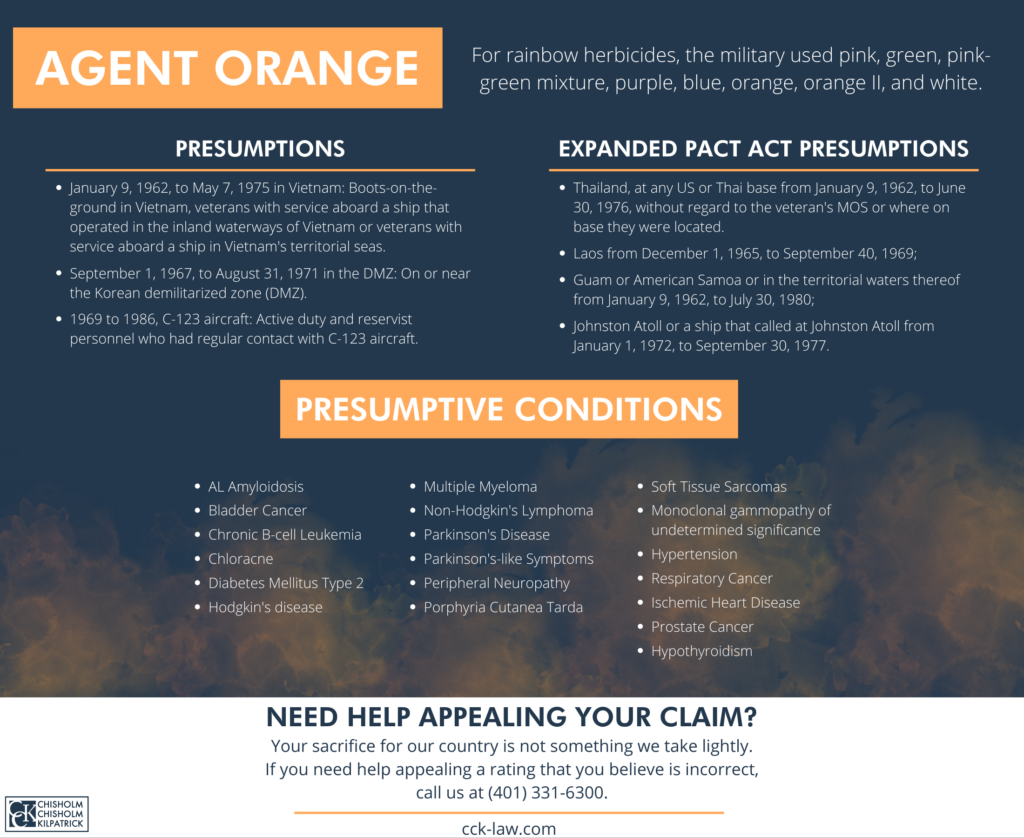Agent Orange in Laos: New Benefits for Veterans and Surviving Dependents

CCK Law: Our Vital Role in Veterans Law
Herbicides, such as Agent Orange, were used in Laos during the Vietnam War Era and were later linked to serious health conditions. With the passage of the Honoring Our PACT Act in 2022, veterans who were exposed to Agent Orange while serving in Laos, as well as their surviving dependents, may now be eligible for compensation. Continue reading to learn more.
What is Agent Orange?
Agent Orange is an herbicide mixture that was used extensively to deforest large areas of the environment during the Vietnam War era. Agent Orange created the highly toxic dioxin contaminant known as 2, 3, 7, 8-Tetrachlorodibenzo-p-dioxin (TCDD) as a byproduct. This dioxin often takes years to break down once it has been released into the environment and can cause a wide array of health effects.
How Was Agent Orange Used in Laos?
To date, the extent to which Agent Orange was used in Laos is not well understood, as little testing has been conducted. The War Legacies Project asserts that, based on U.S. Air Force official spray records that were disclosed in 1999, “at least fifteen districts in the provinces of Kham Mouane, Savannakhet, Salavan, Xekong, and Attapeau were heavily and repeatedly sprayed with tactical herbicides.”
A study conducted by the War Legacies Project further indicated that “the rate of birth defects in sprayed villages in Laos were comparable to the rates of heavily sprayed villages in Vietnam.” These areas are associated with the former Ho Chi Minh trail, which was a trail consisting of various roads that ran from North Vietnam to South Vietnam through areas of Cambodia and Laos.
Honoring Our PACT Act: Presumptive Service Connection for Veterans Exposed to Herbicides
The military used Agent Orange across several countries and areas during the war. As a result of the PACT Act, which became law in 2022, the presumption of herbicide exposure is extended to service members with active military naval, air or space service who served in the following locations/timeframes:
- Vietnam –Veterans are eligible for presumptive service-connection if they served between January 9, 1962 and May 7, 1975.
- Korean Demilitarized Zone – Veterans who served on or near the Korean Demilitarized Zone between September 1, 1967 and August 31, 1971, should also be presumed to have been exposed to herbicide agents.
- Thailand – VA has recognized that herbicide agents were used in Thailand. The recently passed PACT Act creates the presumption of herbicide exposure for veterans with active military naval, air, or space service who served in Thailand, at any US or Thai base, between January 9, 1962 and June 30, 1976.
- Cambodia – Similar to the new Thailand presumptions, the PACT Act extends the presumption of herbicide exposure to those who served in Cambodia, specifically at Mimot or Krek, or Kampong Cham Province between April 16, 1969 and April 30, 1969.
- Guam/American Samoa – Veterans who served in Guam or American Samoa, or in the territorial waters thereof, between January 9, 1962 and July 31, 1980 are eligible for this presumption.
- Johnson Atoll – Those who served on an island called Johnston Atoll, or a ship that called at Johnston Atoll, between January 1, 1972 and September 30, 1977 are also included in the presumptions created by the PACT Act.
- Laos – Herbicide exposure, such as Agent Orange exposure, also occurred in Laos. The PACT Act enables veterans who served between December 1, 1965 and September 30, 1969 are also eligible for the presumption of herbicide exposure.
Essentially, if a veteran served in one of the above-mentioned locations and time periods, then they would be eligible for presumptive service connection. Presumptive service connection places less of the burden of proof on the veteran, as they do not need to prove they were exposed to Agent Orange if their service meets the necessary criteria for presumptive service connection.
When President Biden officially signed the PACT Act into law, he and VA Secretary McDonough announced that the rollout period for certain presumptive conditions for covered veterans would be waived. Initially, these presumptions were effective upon the date of enactment of the PACT Act only for certain conditions, while presumptions for other conditions would become effective on a rolling basis over the next few years. Now, with this new rollout plan, the presumption for all conditions are effective from the date the PACT Act was signed (August 10, 2022) and VA will begin adjudicating these claims as soon as January 2023. Veterans should know, however, that newly eligibly claimants will not get retroactive benefits back to the date of their original claim unless they are filing a claim for DIC benefits.

Adverse Health Effects Relating to Agent Orange
In addition to the presumptions based on location and time of service, VA recognizes that many conditions and their symptoms are linked to Agent Orange, or other herbicide, exposures. As such, the following conditions are considered presumptive by VA, meaning that veterans do not need to provide evidence to prove the link between herbicide exposure and the following conditions:
- AL Amyloidosis: A condition that occurs when a rare and abnormal protein infects your tissues or organs.
- Bladder Cancer: Cancer that affects the cells of the bladder. An act of Congress passed at the end of 2020 instructed VA to expand its presumptive list to include this condition.
- Chronic B-cell Leukemias: A type of blood cancer that affects the white blood cells.
- Chloracne: A skin condition resulting from herbicide exposure and resembling severe acne.
- Diabetes Mellitus Type 2: A condition resulting from a lack of insulin response, which leads to chronically high blood sugar levels.
- Hodgkin’s disease: A type of lymphoma cancer involving abnormal cell growth in the lymph nodes.
- Hypertension: Hypertension means that a person has high blood pressure. For VA compensation purposes, this means a veteran’s blood pressure has a diastolic measurement of 100 or more, or a systolic measurement of 160 or more.
- Hypothyroidism: A condition in which the thyroid gland does not produce enough of certain crucial hormones. This condition was also added to the presumptive list by the 2020 NDAA.
- Ischemic Heart Disease: A progressive condition in which the heart receives inadequate blood supply, resulting in chest pain and other complications. This includes coronary artery disease, stable and unstable angina, myocardial infarction, and sudden cardiac death.
- Monoclonal Gammopathy: Monoclonal gammopathy is a condition where abnormal proteins are found in the blood.
- Multiple Myeloma: A blood cancer affecting plasma cells.
- Non-Hodgkin’s Lymphoma: A cancer of the lymphatic system.
- Parkinson’s Disease: A chronic nervous system disorder that can lead to a progressive lack of mobility and muscle strength.
- Parkinson’s-like Symptoms: A condition with symptoms such as tremors, slow movement, impaired speech, and muscle stiffness that resembles Parkinson’s Disease but is not formally diagnosed as such. Passed by Congress in 2020, the NDAA instructed VA to expand its presumptive list to include this condition.
- Peripheral Neuropathy: A nervous system disorder that causes a number of physical complications, such as weakness, numbness, and constant tingling sensations.
- Porphyria Cutanea Tarda: A liver condition that can cause sun-exposed skin to blister and become more fragile.
- Prostate Cancer: A cancer of the prostate in men.
- Respiratory Cancer: Such as lung cancer and other cancers of the respiratory system.
- Soft Tissue Sarcomas: Cancers that affect the body’s soft tissues, such as muscle, fat, and connective tissue.

How to File for Service Connection if You Were Exposed to Agent Orange in Laos
If you wish to file for service connection for a condition that you may have developed as the result of Agent Orange exposure, you can file for service-connection using VA Form 21-526EZ.
In addition to this form, veterans will need to provide a current diagnosis of the condition for which they are seeking VA disability benefits. They may also need to provide evidence that they served in Laos between December 1, 1965 and September 30, 1969.
If your medical condition is not considered “presumptive,” meaning that it does not appear on the list of presumptive conditions, you may still be able to receive VA disability benefits due to Agent Orange exposure. You will typically need additional evidence to support your case such as a link, or “nexus,” between Agent Orange and your condition.
Honoring Our PACT Act: Benefits Related to Agent Orange Exposure in Laos
As mentioned above, the PACT Act created a presumption of service connection for veterans who served in Laos between December 1, 1965 and September 30, 1969. The passage of the bill also enables the surviving spouses and dependents of veterans who passed away from disabilities linked to Agent Orange exposure in Laos to receive compensation.
Benefits for Widows and Dependents
If a veteran served between December 1, 1965 and September 30, 1969 and developed a condition related to Agent Orange that they later passed away from, that veteran would now be eligible for presumptive service connection. This means that surviving spouses and dependents may be eligible for retroactive Dependency and Indemnity Compensation (DIC) benefits, since the veteran’s death was likely linked to the Agent Orange exposure while serving in Laos.
To file a claim for DIC benefits, the surviving widow or dependent would need to file VA Form 21P-534EZ. If granted, DIC claims will become effective immediately.
Agent Orange Registry Health Exam
Veterans who served during the Vietnam War era may also be eligible for an Agent Orange Registry Health Exam. The purpose of this free exam is to “alert Veterans to possible long-term health problems that may be related to Agent Orange exposure during their military service.”
Importantly, this exam is not a Compensation & Pension (C&P) exam and is not required to receive VA benefits. The Agent Orange Registry Health Exam is based on the veteran’s recollection of service, not their military service records. VA notes that these exams can help them better understand and respond to the effects of Agent Orange.
Through the program, veterans may receive free lab tests and referrals to medical specialists for their Agent Orange-related symptoms.
VA Disability Compensation Rates for Agent Orange-Related Conditions
If you are granted service connection for a medical condition due to Agent Orange exposure, your monthly compensation amounts will depend on your VA disability rating. VA disability ratings are assigned based on the severity of your condition.
As of 2025, the VA disability rate benefit amounts are as follows:
- 0 percent disability rating: $0.00 per month
- 10 percent disability rating: $175.51 per month
- 20 percent disability rating: $346.95 per month
- 30 percent disability rating: $537.42 per month
- 40 percent disability rating: $774.16 per month
- 50 percent disability rating: $1,102.04 per month
- 60 percent disability rating: $1,395.93 per month
- 70 percent disability rating: $1,759.19 per month
- 80 percent disability rating: $2,044.89 per month
- 90 percent disability rating: $2,297.96 per month
- 100 percent disability rating: $3,831.30 per month
Getting Legal Representation to Help with VA Disability Benefits for Agent Orange Exposure in Laos
If you are a veteran, or the surviving spouse of a veteran, who faced Agent Orange exposure in Laos during your military service, help is available to you. Our team has helped many veterans win VA disability benefits for conditions linked to Agent Orange exposure and we may be able to help you too. Call our office today for a free case evaluation.
About the Author
Share this Post
